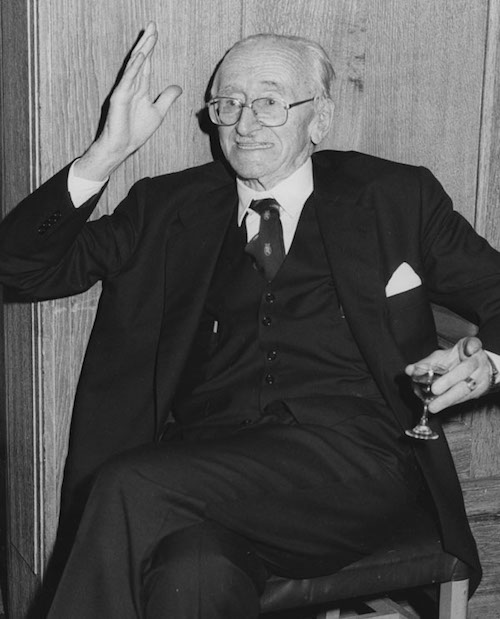Leisure • Political Theory
Friedrich Hayek
Friedrich August von Hayek (1899-1992) was a political economist who had a tremendous influence upon how people in capitalist societies understand the concept of liberty. Controversially, for Hayek ‘liberty’ did not mean democracy or a commitment to a set of ‘liberal’ ideals. Rather, Hayek believed that liberty was ‘a policy which deliberately adopts competition, markets and prices as its ordering principles’. To Hayek’s way of thinking, it was markets that guaranteed individual liberty. And, by contrast, it was the interference of the state in markets that disrupted the operation of liberty and started society down, as he famously put it, the road to serfdom.
Hayek was born into a minor part of the Austro-Hungarian aristocracy. His father, who came from a line of scholars, was a medical doctor and part time lecturer in botany. Hayek’s childhood was filled with consideration of philosophy and economics. After a brief stint in the Austro-Hungarian army during the First World War, Hayek took up studies at the University of Vienna, obtaining doctorates in law and political science, and afterwards he became an academic economist.
Hayek’s career can be divided into two periods. The first, which ended towards the end of the 1940s, was spent mainly at the London School of Economics where Hayek concerned himself with many of the macroeconomic debates of the day. The second half of Hayek’s career was much more varied. From 1945 onwards in, first, Chicago and, later, Freiberg, Los Angeles, and Salzburg, Hayek wrote and lectured on a whole range of subjects – economics, yes, but also politics, psychology, philosophy, and the philosophy of science. And whilst he officially retired in 1968, it was actually in the 1970s and 1980s that Hayek enjoyed his greatest moments of influence, being awarded the Nobel Prize in Economic Sciences in 1974 and subsequently being influential upon the governments of Ronald Reagan and Margaret Thatcher.
Development of Key Ideas
During Hayek’s stay at the London School of Economics, which he joined in 1931, he wrestled with a number of the then contemporary debates within economic theory. Much of this revolved around the business cycle which, put simply, is the way in which economies grow and contract. Traditional economic theory held that, over time, economies find themselves in equilibrium. In short, gluts and shortages should balance out via market mechanisms, leading to the optimal distribution of resources within an economy. The problem was that the economic peaks and troughs seemed to keep occurring and they also seemed to be more dramatic than they should be. When the world economy stagnated and then crashed in the late 1920s and during the 1930s, fierce debate began as to why this had occurred.
Coming at economics from a fairly classical position, Hayek focussed on issues of supply. Hayek noticed that when economies were in a recession, central banks often artificially injected more money into the economy by printing cash or else (or in addition) by holding interest rates low to encourage investment, rather than saving. Hayek argued that this was a mistake. When money was too readily available, entrepreneurs invested in products which were not necessarily desired by consumers. When these products went unsold, companies went bankrupt leaving industrial capacity invested where it need not be. In addition, cheap credit incentivised long-term capital investment and Hayek argued that this too was a problem because it limited the possibility of entrepreneurs attempting to realise short-term gains which could kick-start the economy. Resisting the temptation to meddle in the money supply was, for Hayek, crucial to solving the problems of the Great Depression.
Rivalry with Keynes
Hayek’s colleagues at the London School of Economics were receptive to his more classical approach to economics. But, up the road in Cambridge, a very different set of ideas was emerging, centred on the thought of John Maynard Keynes. Keynes argued that the problems of the 1930s economy were located not so much in issues of supply, but rather demand. For Keynes, the role of government was to invest in public works, the building of roads for example, which would create employment and therefore give people money to spend, stimulating economic growth. For Keynes, full employment was, therefore, not only a laudable social goal but vital for the economy too.
Keynes’s demand-led economics was fundamentally at odds with Hayek’s ideas. Hayek felt that Keynes’s focus on full employment would require governments to keep increasing money supply. This, in turn, would create severe inflation of the kind that had wiped out his family’s savings when 1920s Austria suffered a bout of hyperinflation. Throughout the 1930s Hayek and Keynes corresponded with each other, argued bitterly and found very little common ground. During the Second World War, they even met, under bizarre circumstances. Because of the German bombing campaign against London, the LSE had been evacuated to Cambridge. One night, Keynes and Hayek were assigned to fire watch duty together on the roof of the chapel of King’s College. Sadly, we do not know what it was that they talked about throughout that night.
The Road to Serfdom
The opening of the second half of Hayek’s career is marked by his first foray out from dry economic arguments and the publication of what is probably his most famous work, The Road to Serfdom. Hayek saw the writing of this book as a form of war work, forced upon him because, as a former enemy combatant, Hayek was refused official service in the British war effort. Against the backdrop of Keynes’s ideas on planning, which had become accepted within British government circles, The Road to Serfdom was an attempt to save people from themselves, or more accurately, from government.
Hayek put forward several key arguments:
1. That there was nothing intrinsic to Germans as a race of people that had caused them to adopt authoritarian forms of government. Hayek rejected the idea, somewhat popular at the time, that there was something about German culture, or indeed inherent to Germans as a race, which predisposed them to authoritarian and expansionist forms of government.
2. Hayek argued that where Germany, and the Soviet Union too for that matter, had gone wrong was in undertaking state planning that interfered in the natural operation of markets. For Hayek, the problem with state planning was that it necessarily involved offering up responsibility for deciding upon a plan to a single individual. In a bureaucratic system, such as the state, Hayek argued, someone had to ultimately decide on what course of action should be taken. And that person’s judgement would necessarily have to be deferred to and deferred to repeatedly over a given period of time. In this sense, planning led societies to sleepwalk into dictatorship.
3. Not only did Hayek worry about the inherent need for planners to defer to a single individual, but also he was concerned that fundamentally no one individual could actually make rational choices in regards to economic problems due to them not having enough information to base decisions upon. To be clear, it was not that Hayek necessarily condemned dictatorship. After all, his vision of liberty was a society in which markets were the principle method of economic organisation, not necessarily one where society collectively decided upon governments via the ballot box. To this end, Hayek was comfortable with dictators who adopted free market economic policies involving minimal state intervention in a nation’s economy. But dictators who undertook economic planning were, for Hayek, a great evil.
Hayek saw it like this; markets are extremely complicated networks with millions if not billions of transactions going on all the time. Even consideration of some of the basics of market transactions shows this – items are bought and sold, commodities are invested in and divested from, and famines and bumper crop yields affect how much there is to eat and how much it will cost to acquire it, in keeping with the laws of supply and demand. When individuals make choices as to whether or not to buy a commodity, they affect that commodity’s price. If it becomes scarce, its price increases. If it becomes plentiful, its price falls. In this sense, the free market acts as a kind of constant referendum on the value of goods within an economy. For Hayek, the market represented a form of collective agreement, made amongst all of the people operating in that market, as to the value of particular goods and services. And against the collective wisdom of hundreds, or thousands, or millions of people, what could one single planner hope to offer that represented a superior form of wisdom? Liberty, therefore, was to be found by letting the market do its work.
Later Career
The Road to Serfdom launched Hayek’s later career. Instantly, it became a bestseller (during the Second World War its print run was limited due to paper shortages and obtaining a copy was nigh-on impossible due to sheer demand). In the United States, a condensed Readers’ Digest version of the book brought the message to the public at large. So too did a series of lectures delivered by Hayek during 1945 at various venues in the United States. Hayek, cold shouldered by British policy makers and economists, was delighted at the reception he received in the US and in 1950 he moved to the University of Chicago, which became the centre of neoliberal economic thinking, with which Hayek was closely associated, much as Cambridge had been the locus for Keynesian economics.
But despite the popular acclaim of The Road to Serfdom, two negative reactions irked him. First of all, some of his own colleagues, normally sympathetic to the ideas he put forward, saw The Road to Serfdom as a kind of light-weight form of journalism, rather than as a form of scholarship. Second, Keynes, who read The Road to Serfdom, sent Hayek what was, for the most part, a complementary message about its content. However, towards the end, and in quick order, Keynes challenged Hayek as to where he would draw the line on government planning. Some planning was clearly needed, Hayek was not an economic anarchist after all, but, Keynes challenged, where would the line be drawn?
It took Hayek many years to work out his response to Keynes (who died in 1946) but the response eventually came in 1960 in Hayek’s book The Constitution of Liberty. The book laid out Hayek’s practical vision for where the line between the state and market should be drawn and was highly influential amongst the political right. In an anecdote with, admittedly, somewhat apocryphal tinges to it, a story is told that at a meeting with the Conservative Research Department in 1975, Margaret Thatcher responded to a policy paper on political philosophy by reaching into her handbag and withdrawing a copy of The Constitution of Liberty. Holding it aloft, Thatcher declared “This is what we believe”.
Legacy
As the twentieth century unfolded, Hayek’s ideas gained more common currency. The idea that the state should limit itself to providing a legal framework within which entrepreneurs can engage with free markets is at the heart of much of economic thinking in the world today. Many politicians, and large sections of the public too, are sceptical about the ability of the state to plan and undertake anything but the most simple of economic tasks, and this owes much to Hayek’s warnings about the anti-libertarian perils of planning and the inability of planners to truly understand the world around them.
Even when the financial crisis of 2007-8 hit the world economy, leading to a prolonged recession, faith in government planning was not restored in the popular imagination. This was best testified by The Road to Serfdom hitting the number one spot on the Amazon book bestseller list in 2010, despite it having been written over sixty years ago.































